COMM101: Community Engagement, Skills, Employability - Report Analysis
VerifiedAdded on 2022/09/14
|14
|2702
|42
Report
AI Summary
This report provides a comprehensive overview of community engagement, its various types, and the skills it fosters to enhance employability. It delves into the theoretical foundations of community engagement, emphasizing the importance of building connections, acting with humility, developing understanding, affirming dignity, and pursuing justice as core pillars. The report examines different types of community engagement, including direct service, community research, advocacy, capacity building, political involvement, philanthropy, and project-based engagement. It also addresses the challenges faced by community workers and highlights how community engagement contributes to self-development and professional growth. Furthermore, the report discusses how community engagement can be applied practically to achieve specific objectives, fostering positive social and organizational outcomes. This report is contributed by a student and available on Desklib, a platform offering AI-based study tools and resources.
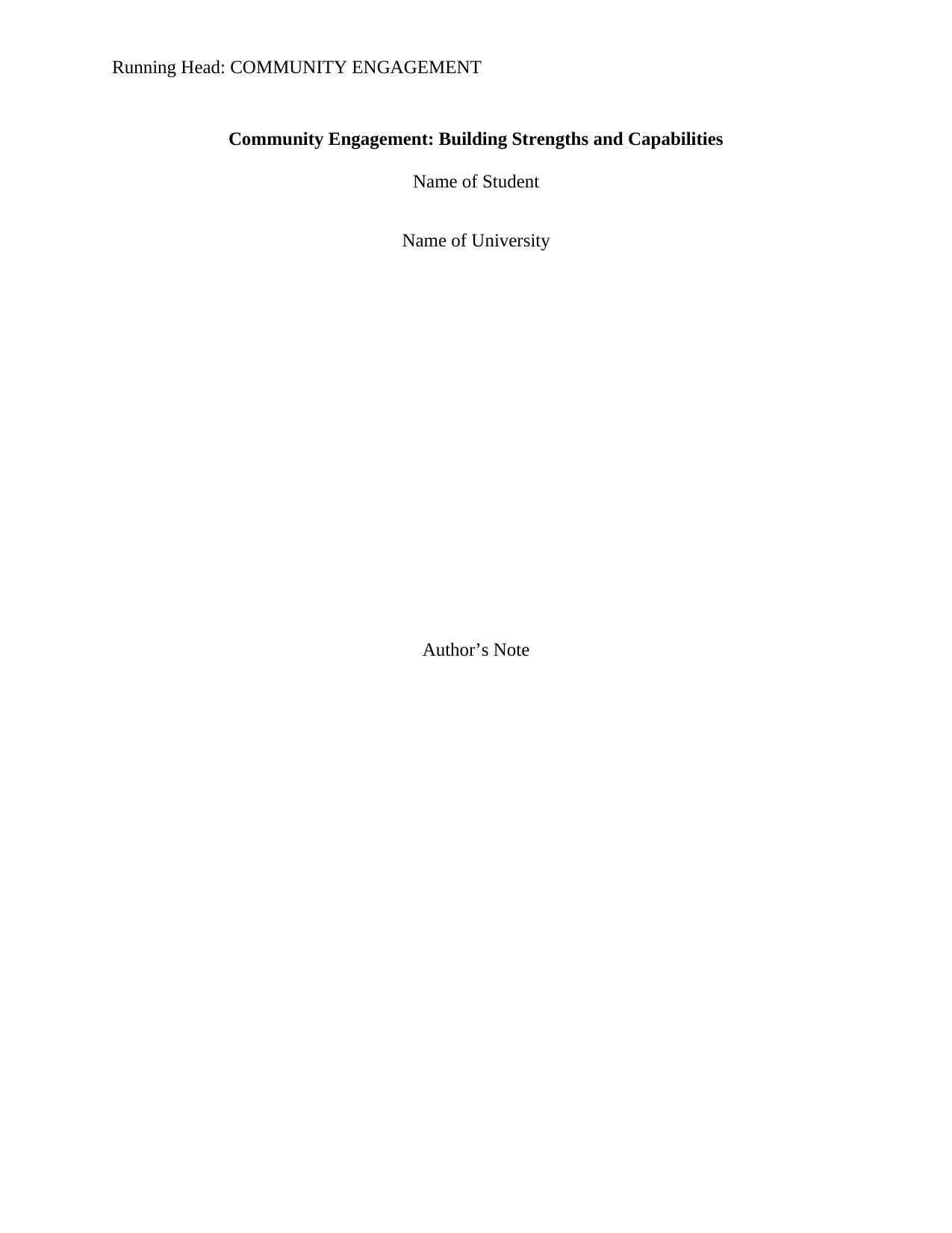
Running Head: COMMUNITY ENGAGEMENT
Community Engagement: Building Strengths and Capabilities
Name of Student
Name of University
Author’s Note
Community Engagement: Building Strengths and Capabilities
Name of Student
Name of University
Author’s Note
Paraphrase This Document
Need a fresh take? Get an instant paraphrase of this document with our AI Paraphraser
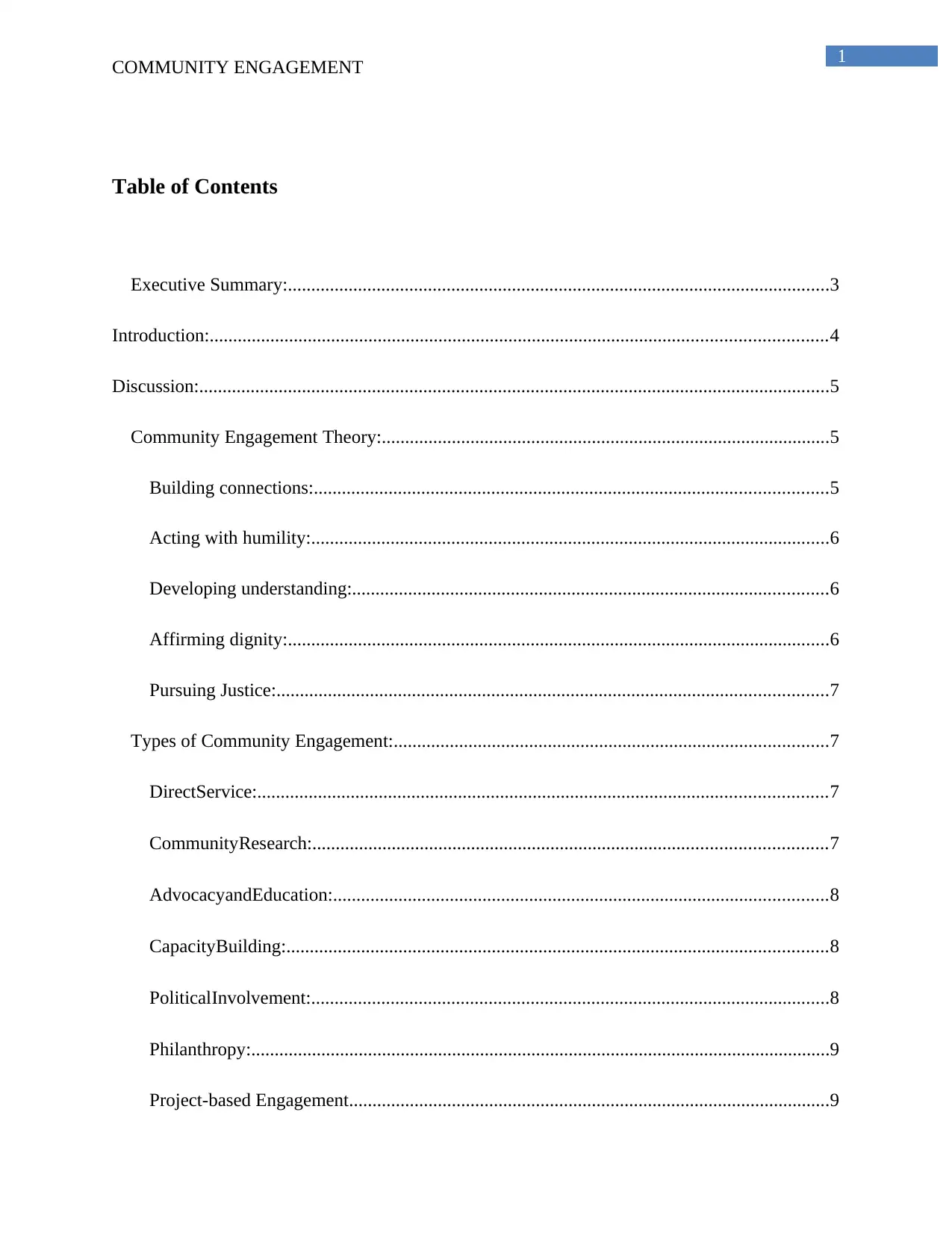
1
COMMUNITY ENGAGEMENT
Table of Contents
Executive Summary:....................................................................................................................3
Introduction:....................................................................................................................................4
Discussion:.......................................................................................................................................5
Community Engagement Theory:................................................................................................5
Building connections:..............................................................................................................5
Acting with humility:...............................................................................................................6
Developing understanding:......................................................................................................6
Affirming dignity:....................................................................................................................6
Pursuing Justice:......................................................................................................................7
Types of Community Engagement:.............................................................................................7
DirectService:..........................................................................................................................7
CommunityResearch:..............................................................................................................7
AdvocacyandEducation:..........................................................................................................8
CapacityBuilding:....................................................................................................................8
PoliticalInvolvement:...............................................................................................................8
Philanthropy:............................................................................................................................9
Project-based Engagement.......................................................................................................9
COMMUNITY ENGAGEMENT
Table of Contents
Executive Summary:....................................................................................................................3
Introduction:....................................................................................................................................4
Discussion:.......................................................................................................................................5
Community Engagement Theory:................................................................................................5
Building connections:..............................................................................................................5
Acting with humility:...............................................................................................................6
Developing understanding:......................................................................................................6
Affirming dignity:....................................................................................................................6
Pursuing Justice:......................................................................................................................7
Types of Community Engagement:.............................................................................................7
DirectService:..........................................................................................................................7
CommunityResearch:..............................................................................................................7
AdvocacyandEducation:..........................................................................................................8
CapacityBuilding:....................................................................................................................8
PoliticalInvolvement:...............................................................................................................8
Philanthropy:............................................................................................................................9
Project-based Engagement.......................................................................................................9
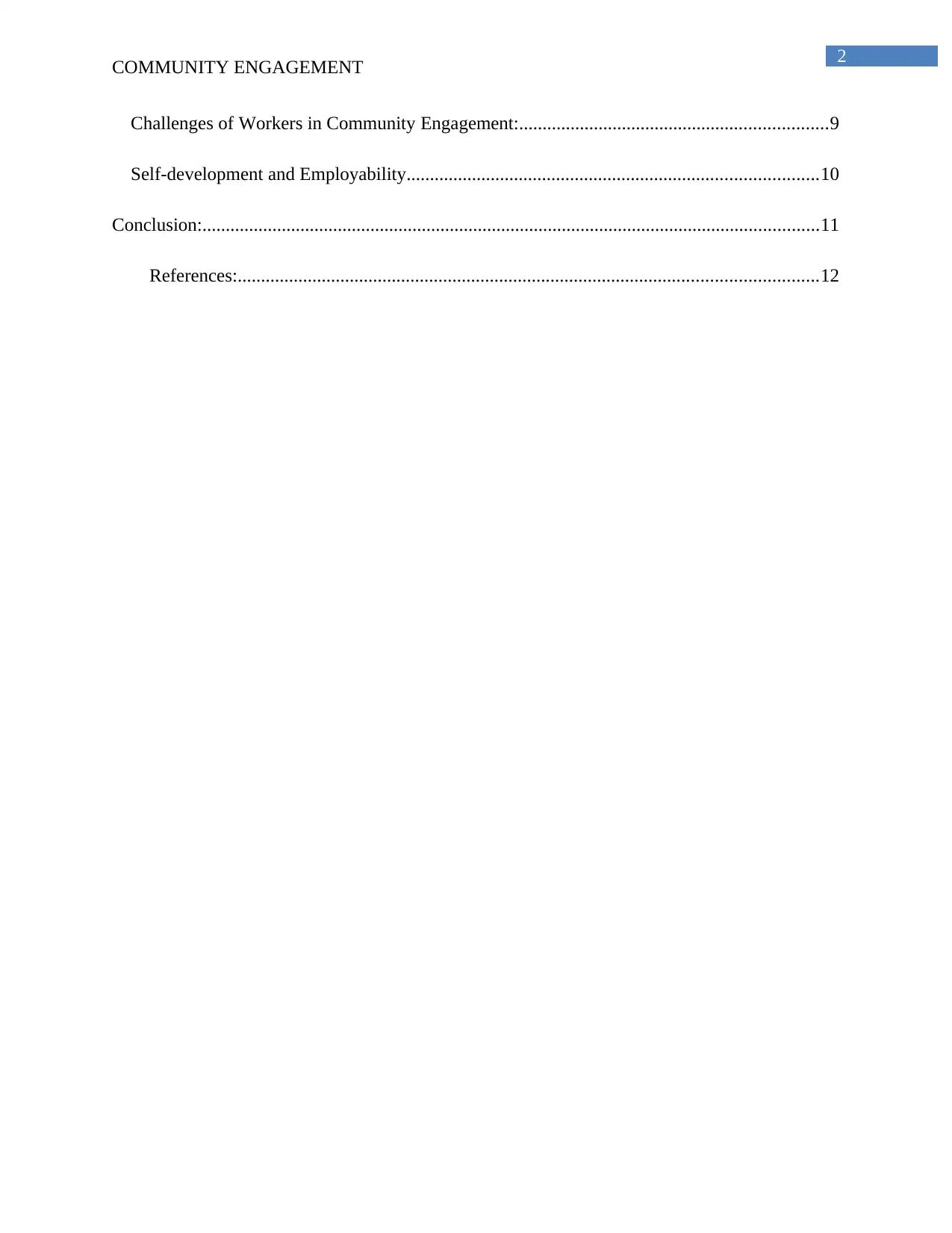
2
COMMUNITY ENGAGEMENT
Challenges of Workers in Community Engagement:..................................................................9
Self-development and Employability........................................................................................10
Conclusion:....................................................................................................................................11
References:............................................................................................................................12
COMMUNITY ENGAGEMENT
Challenges of Workers in Community Engagement:..................................................................9
Self-development and Employability........................................................................................10
Conclusion:....................................................................................................................................11
References:............................................................................................................................12
⊘ This is a preview!⊘
Do you want full access?
Subscribe today to unlock all pages.

Trusted by 1+ million students worldwide
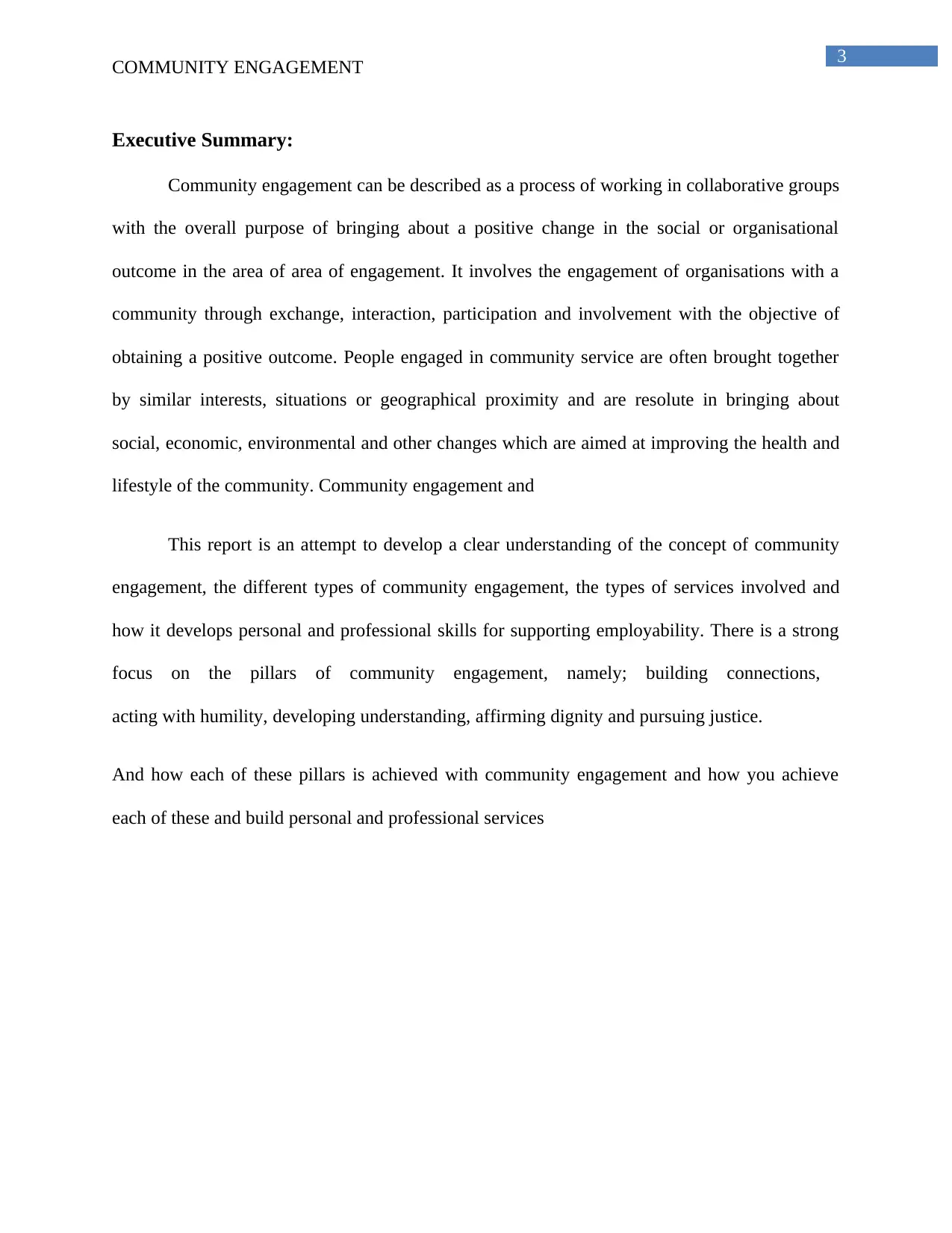
3
COMMUNITY ENGAGEMENT
Executive Summary:
Community engagement can be described as a process of working in collaborative groups
with the overall purpose of bringing about a positive change in the social or organisational
outcome in the area of area of engagement. It involves the engagement of organisations with a
community through exchange, interaction, participation and involvement with the objective of
obtaining a positive outcome. People engaged in community service are often brought together
by similar interests, situations or geographical proximity and are resolute in bringing about
social, economic, environmental and other changes which are aimed at improving the health and
lifestyle of the community. Community engagement and
This report is an attempt to develop a clear understanding of the concept of community
engagement, the different types of community engagement, the types of services involved and
how it develops personal and professional skills for supporting employability. There is a strong
focus on the pillars of community engagement, namely; building connections,
acting with humility, developing understanding, affirming dignity and pursuing justice.
And how each of these pillars is achieved with community engagement and how you achieve
each of these and build personal and professional services
COMMUNITY ENGAGEMENT
Executive Summary:
Community engagement can be described as a process of working in collaborative groups
with the overall purpose of bringing about a positive change in the social or organisational
outcome in the area of area of engagement. It involves the engagement of organisations with a
community through exchange, interaction, participation and involvement with the objective of
obtaining a positive outcome. People engaged in community service are often brought together
by similar interests, situations or geographical proximity and are resolute in bringing about
social, economic, environmental and other changes which are aimed at improving the health and
lifestyle of the community. Community engagement and
This report is an attempt to develop a clear understanding of the concept of community
engagement, the different types of community engagement, the types of services involved and
how it develops personal and professional skills for supporting employability. There is a strong
focus on the pillars of community engagement, namely; building connections,
acting with humility, developing understanding, affirming dignity and pursuing justice.
And how each of these pillars is achieved with community engagement and how you achieve
each of these and build personal and professional services
Paraphrase This Document
Need a fresh take? Get an instant paraphrase of this document with our AI Paraphraser
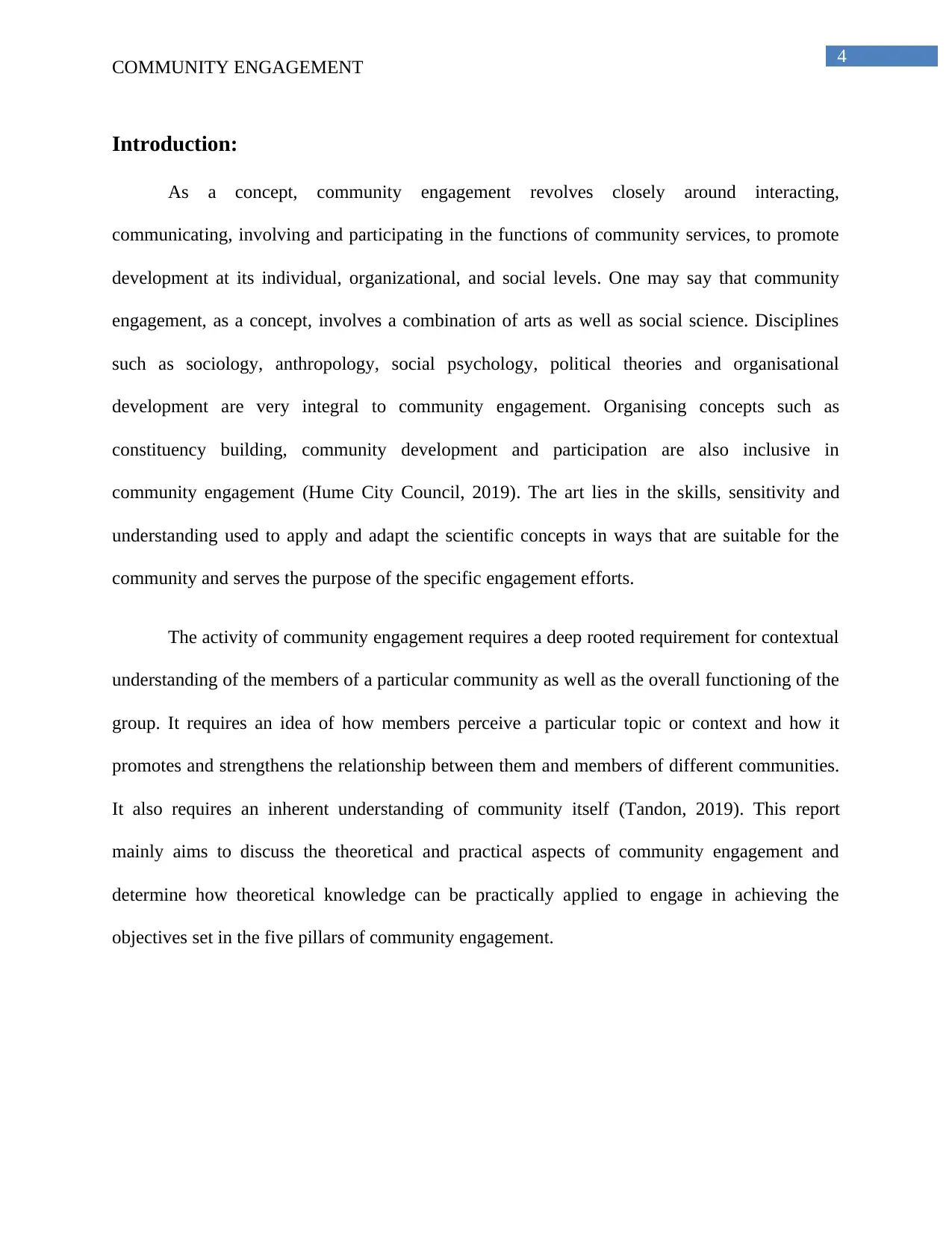
4
COMMUNITY ENGAGEMENT
Introduction:
As a concept, community engagement revolves closely around interacting,
communicating, involving and participating in the functions of community services, to promote
development at its individual, organizational, and social levels. One may say that community
engagement, as a concept, involves a combination of arts as well as social science. Disciplines
such as sociology, anthropology, social psychology, political theories and organisational
development are very integral to community engagement. Organising concepts such as
constituency building, community development and participation are also inclusive in
community engagement (Hume City Council, 2019). The art lies in the skills, sensitivity and
understanding used to apply and adapt the scientific concepts in ways that are suitable for the
community and serves the purpose of the specific engagement efforts.
The activity of community engagement requires a deep rooted requirement for contextual
understanding of the members of a particular community as well as the overall functioning of the
group. It requires an idea of how members perceive a particular topic or context and how it
promotes and strengthens the relationship between them and members of different communities.
It also requires an inherent understanding of community itself (Tandon, 2019). This report
mainly aims to discuss the theoretical and practical aspects of community engagement and
determine how theoretical knowledge can be practically applied to engage in achieving the
objectives set in the five pillars of community engagement.
COMMUNITY ENGAGEMENT
Introduction:
As a concept, community engagement revolves closely around interacting,
communicating, involving and participating in the functions of community services, to promote
development at its individual, organizational, and social levels. One may say that community
engagement, as a concept, involves a combination of arts as well as social science. Disciplines
such as sociology, anthropology, social psychology, political theories and organisational
development are very integral to community engagement. Organising concepts such as
constituency building, community development and participation are also inclusive in
community engagement (Hume City Council, 2019). The art lies in the skills, sensitivity and
understanding used to apply and adapt the scientific concepts in ways that are suitable for the
community and serves the purpose of the specific engagement efforts.
The activity of community engagement requires a deep rooted requirement for contextual
understanding of the members of a particular community as well as the overall functioning of the
group. It requires an idea of how members perceive a particular topic or context and how it
promotes and strengthens the relationship between them and members of different communities.
It also requires an inherent understanding of community itself (Tandon, 2019). This report
mainly aims to discuss the theoretical and practical aspects of community engagement and
determine how theoretical knowledge can be practically applied to engage in achieving the
objectives set in the five pillars of community engagement.
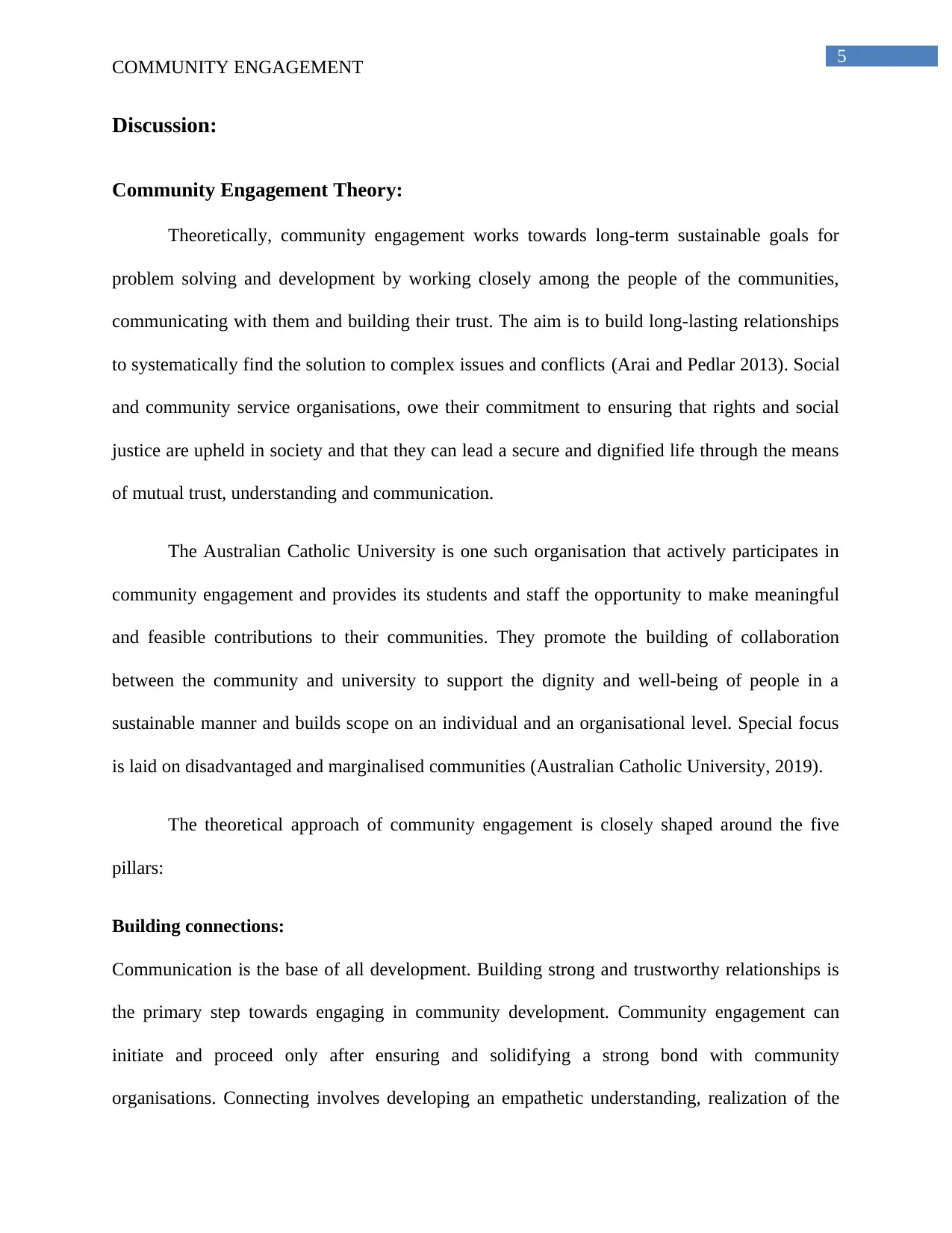
5
COMMUNITY ENGAGEMENT
Discussion:
Community Engagement Theory:
Theoretically, community engagement works towards long-term sustainable goals for
problem solving and development by working closely among the people of the communities,
communicating with them and building their trust. The aim is to build long-lasting relationships
to systematically find the solution to complex issues and conflicts (Arai and Pedlar 2013). Social
and community service organisations, owe their commitment to ensuring that rights and social
justice are upheld in society and that they can lead a secure and dignified life through the means
of mutual trust, understanding and communication.
The Australian Catholic University is one such organisation that actively participates in
community engagement and provides its students and staff the opportunity to make meaningful
and feasible contributions to their communities. They promote the building of collaboration
between the community and university to support the dignity and well-being of people in a
sustainable manner and builds scope on an individual and an organisational level. Special focus
is laid on disadvantaged and marginalised communities (Australian Catholic University, 2019).
The theoretical approach of community engagement is closely shaped around the five
pillars:
Building connections:
Communication is the base of all development. Building strong and trustworthy relationships is
the primary step towards engaging in community development. Community engagement can
initiate and proceed only after ensuring and solidifying a strong bond with community
organisations. Connecting involves developing an empathetic understanding, realization of the
COMMUNITY ENGAGEMENT
Discussion:
Community Engagement Theory:
Theoretically, community engagement works towards long-term sustainable goals for
problem solving and development by working closely among the people of the communities,
communicating with them and building their trust. The aim is to build long-lasting relationships
to systematically find the solution to complex issues and conflicts (Arai and Pedlar 2013). Social
and community service organisations, owe their commitment to ensuring that rights and social
justice are upheld in society and that they can lead a secure and dignified life through the means
of mutual trust, understanding and communication.
The Australian Catholic University is one such organisation that actively participates in
community engagement and provides its students and staff the opportunity to make meaningful
and feasible contributions to their communities. They promote the building of collaboration
between the community and university to support the dignity and well-being of people in a
sustainable manner and builds scope on an individual and an organisational level. Special focus
is laid on disadvantaged and marginalised communities (Australian Catholic University, 2019).
The theoretical approach of community engagement is closely shaped around the five
pillars:
Building connections:
Communication is the base of all development. Building strong and trustworthy relationships is
the primary step towards engaging in community development. Community engagement can
initiate and proceed only after ensuring and solidifying a strong bond with community
organisations. Connecting involves developing an empathetic understanding, realization of the
⊘ This is a preview!⊘
Do you want full access?
Subscribe today to unlock all pages.

Trusted by 1+ million students worldwide
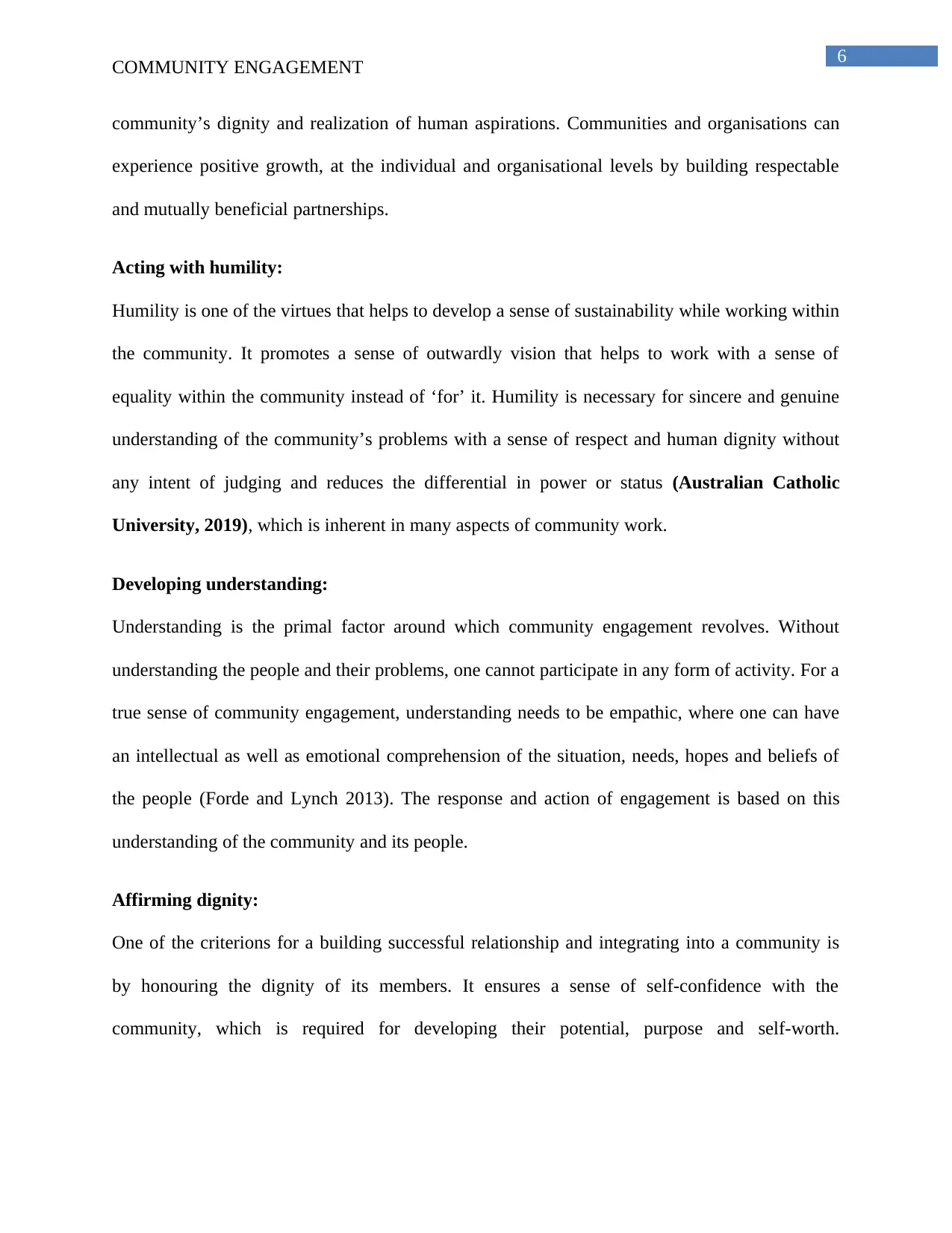
6
COMMUNITY ENGAGEMENT
community’s dignity and realization of human aspirations. Communities and organisations can
experience positive growth, at the individual and organisational levels by building respectable
and mutually beneficial partnerships.
Acting with humility:
Humility is one of the virtues that helps to develop a sense of sustainability while working within
the community. It promotes a sense of outwardly vision that helps to work with a sense of
equality within the community instead of ‘for’ it. Humility is necessary for sincere and genuine
understanding of the community’s problems with a sense of respect and human dignity without
any intent of judging and reduces the differential in power or status (Australian Catholic
University, 2019), which is inherent in many aspects of community work.
Developing understanding:
Understanding is the primal factor around which community engagement revolves. Without
understanding the people and their problems, one cannot participate in any form of activity. For a
true sense of community engagement, understanding needs to be empathic, where one can have
an intellectual as well as emotional comprehension of the situation, needs, hopes and beliefs of
the people (Forde and Lynch 2013). The response and action of engagement is based on this
understanding of the community and its people.
Affirming dignity:
One of the criterions for a building successful relationship and integrating into a community is
by honouring the dignity of its members. It ensures a sense of self-confidence with the
community, which is required for developing their potential, purpose and self-worth.
COMMUNITY ENGAGEMENT
community’s dignity and realization of human aspirations. Communities and organisations can
experience positive growth, at the individual and organisational levels by building respectable
and mutually beneficial partnerships.
Acting with humility:
Humility is one of the virtues that helps to develop a sense of sustainability while working within
the community. It promotes a sense of outwardly vision that helps to work with a sense of
equality within the community instead of ‘for’ it. Humility is necessary for sincere and genuine
understanding of the community’s problems with a sense of respect and human dignity without
any intent of judging and reduces the differential in power or status (Australian Catholic
University, 2019), which is inherent in many aspects of community work.
Developing understanding:
Understanding is the primal factor around which community engagement revolves. Without
understanding the people and their problems, one cannot participate in any form of activity. For a
true sense of community engagement, understanding needs to be empathic, where one can have
an intellectual as well as emotional comprehension of the situation, needs, hopes and beliefs of
the people (Forde and Lynch 2013). The response and action of engagement is based on this
understanding of the community and its people.
Affirming dignity:
One of the criterions for a building successful relationship and integrating into a community is
by honouring the dignity of its members. It ensures a sense of self-confidence with the
community, which is required for developing their potential, purpose and self-worth.
Paraphrase This Document
Need a fresh take? Get an instant paraphrase of this document with our AI Paraphraser
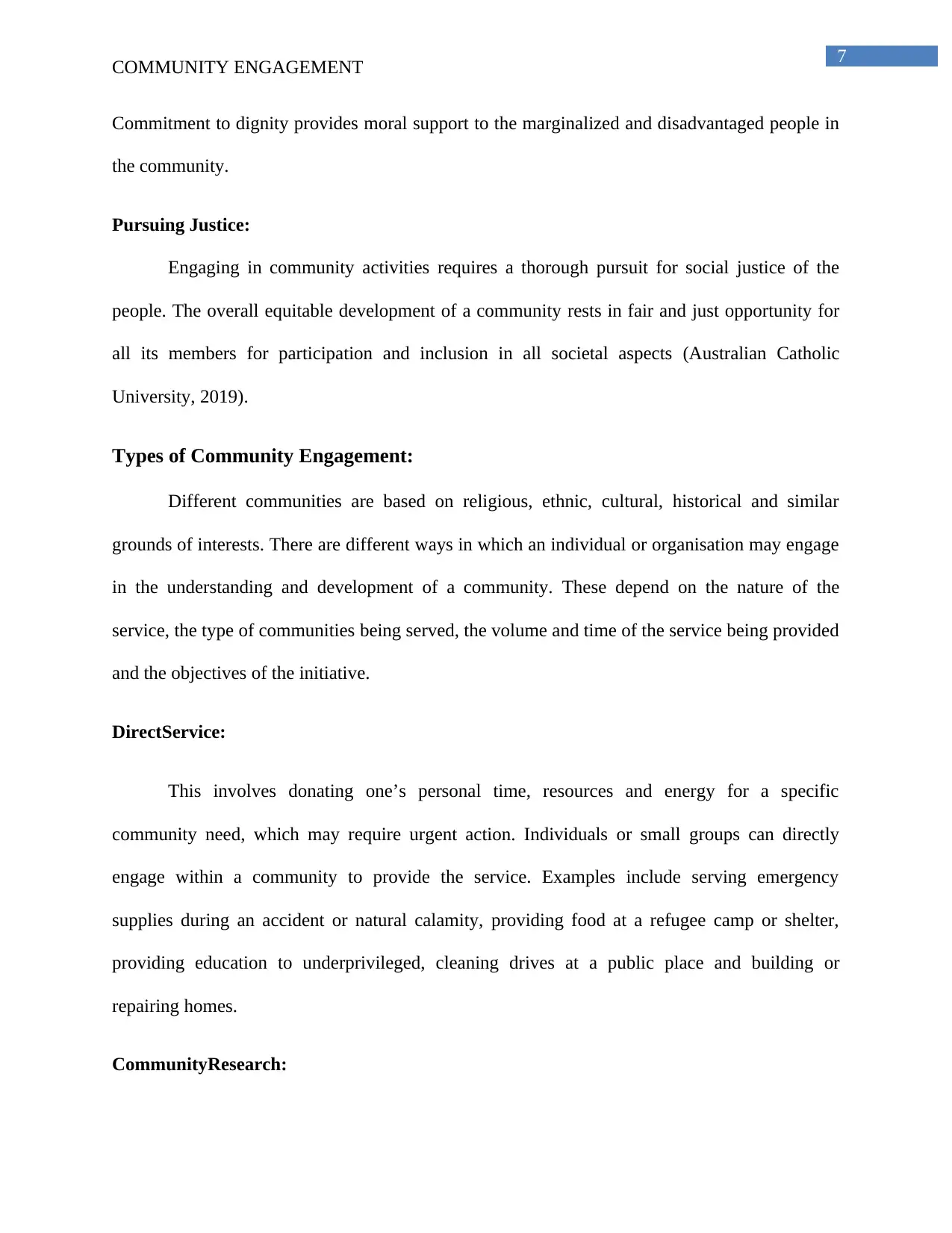
7
COMMUNITY ENGAGEMENT
Commitment to dignity provides moral support to the marginalized and disadvantaged people in
the community.
Pursuing Justice:
Engaging in community activities requires a thorough pursuit for social justice of the
people. The overall equitable development of a community rests in fair and just opportunity for
all its members for participation and inclusion in all societal aspects (Australian Catholic
University, 2019).
Types of Community Engagement:
Different communities are based on religious, ethnic, cultural, historical and similar
grounds of interests. There are different ways in which an individual or organisation may engage
in the understanding and development of a community. These depend on the nature of the
service, the type of communities being served, the volume and time of the service being provided
and the objectives of the initiative.
DirectService:
This involves donating one’s personal time, resources and energy for a specific
community need, which may require urgent action. Individuals or small groups can directly
engage within a community to provide the service. Examples include serving emergency
supplies during an accident or natural calamity, providing food at a refugee camp or shelter,
providing education to underprivileged, cleaning drives at a public place and building or
repairing homes.
CommunityResearch:
COMMUNITY ENGAGEMENT
Commitment to dignity provides moral support to the marginalized and disadvantaged people in
the community.
Pursuing Justice:
Engaging in community activities requires a thorough pursuit for social justice of the
people. The overall equitable development of a community rests in fair and just opportunity for
all its members for participation and inclusion in all societal aspects (Australian Catholic
University, 2019).
Types of Community Engagement:
Different communities are based on religious, ethnic, cultural, historical and similar
grounds of interests. There are different ways in which an individual or organisation may engage
in the understanding and development of a community. These depend on the nature of the
service, the type of communities being served, the volume and time of the service being provided
and the objectives of the initiative.
DirectService:
This involves donating one’s personal time, resources and energy for a specific
community need, which may require urgent action. Individuals or small groups can directly
engage within a community to provide the service. Examples include serving emergency
supplies during an accident or natural calamity, providing food at a refugee camp or shelter,
providing education to underprivileged, cleaning drives at a public place and building or
repairing homes.
CommunityResearch:
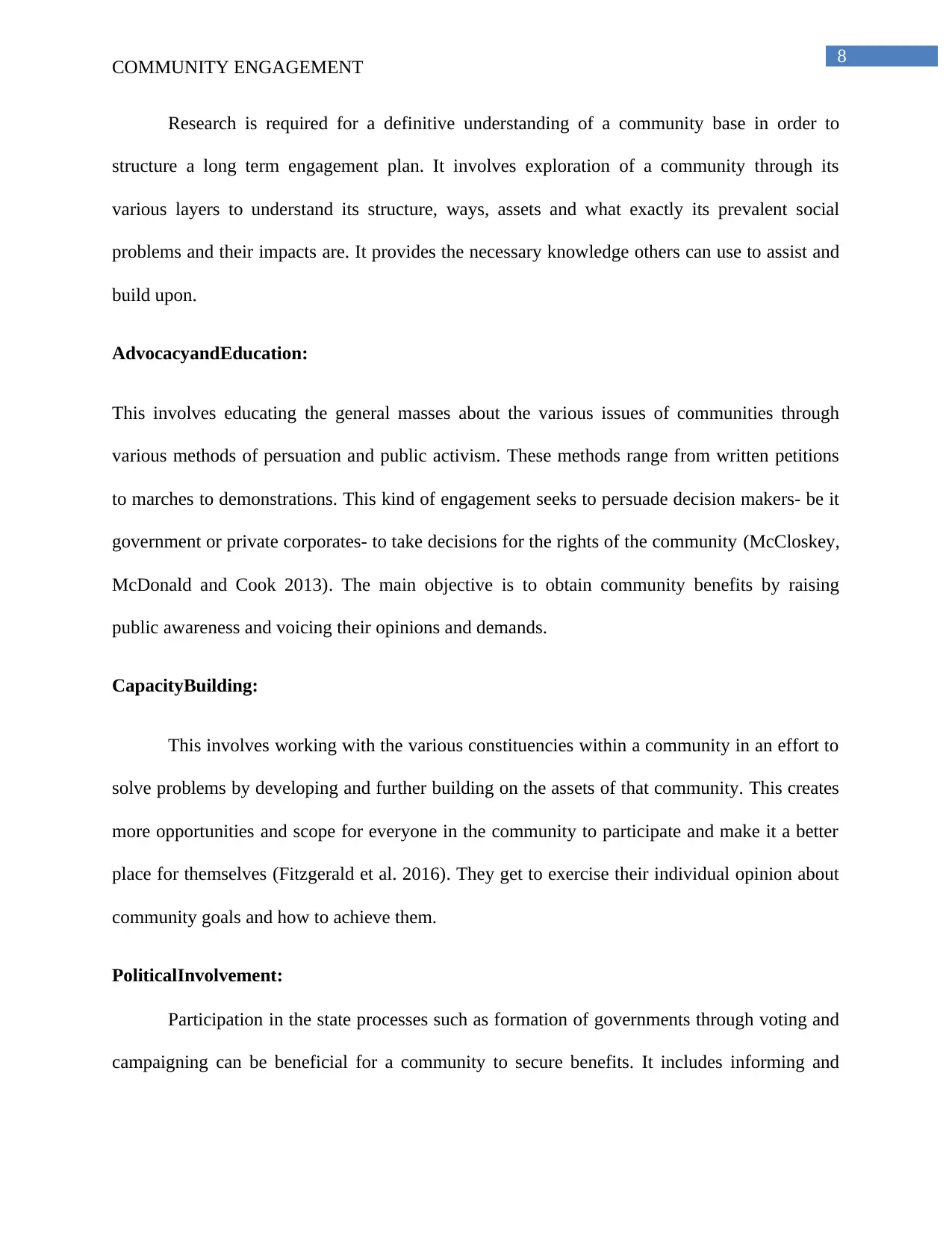
8
COMMUNITY ENGAGEMENT
Research is required for a definitive understanding of a community base in order to
structure a long term engagement plan. It involves exploration of a community through its
various layers to understand its structure, ways, assets and what exactly its prevalent social
problems and their impacts are. It provides the necessary knowledge others can use to assist and
build upon.
AdvocacyandEducation:
This involves educating the general masses about the various issues of communities through
various methods of persuation and public activism. These methods range from written petitions
to marches to demonstrations. This kind of engagement seeks to persuade decision makers- be it
government or private corporates- to take decisions for the rights of the community (McCloskey,
McDonald and Cook 2013). The main objective is to obtain community benefits by raising
public awareness and voicing their opinions and demands.
CapacityBuilding:
This involves working with the various constituencies within a community in an effort to
solve problems by developing and further building on the assets of that community. This creates
more opportunities and scope for everyone in the community to participate and make it a better
place for themselves (Fitzgerald et al. 2016). They get to exercise their individual opinion about
community goals and how to achieve them.
PoliticalInvolvement:
Participation in the state processes such as formation of governments through voting and
campaigning can be beneficial for a community to secure benefits. It includes informing and
COMMUNITY ENGAGEMENT
Research is required for a definitive understanding of a community base in order to
structure a long term engagement plan. It involves exploration of a community through its
various layers to understand its structure, ways, assets and what exactly its prevalent social
problems and their impacts are. It provides the necessary knowledge others can use to assist and
build upon.
AdvocacyandEducation:
This involves educating the general masses about the various issues of communities through
various methods of persuation and public activism. These methods range from written petitions
to marches to demonstrations. This kind of engagement seeks to persuade decision makers- be it
government or private corporates- to take decisions for the rights of the community (McCloskey,
McDonald and Cook 2013). The main objective is to obtain community benefits by raising
public awareness and voicing their opinions and demands.
CapacityBuilding:
This involves working with the various constituencies within a community in an effort to
solve problems by developing and further building on the assets of that community. This creates
more opportunities and scope for everyone in the community to participate and make it a better
place for themselves (Fitzgerald et al. 2016). They get to exercise their individual opinion about
community goals and how to achieve them.
PoliticalInvolvement:
Participation in the state processes such as formation of governments through voting and
campaigning can be beneficial for a community to secure benefits. It includes informing and
⊘ This is a preview!⊘
Do you want full access?
Subscribe today to unlock all pages.

Trusted by 1+ million students worldwide
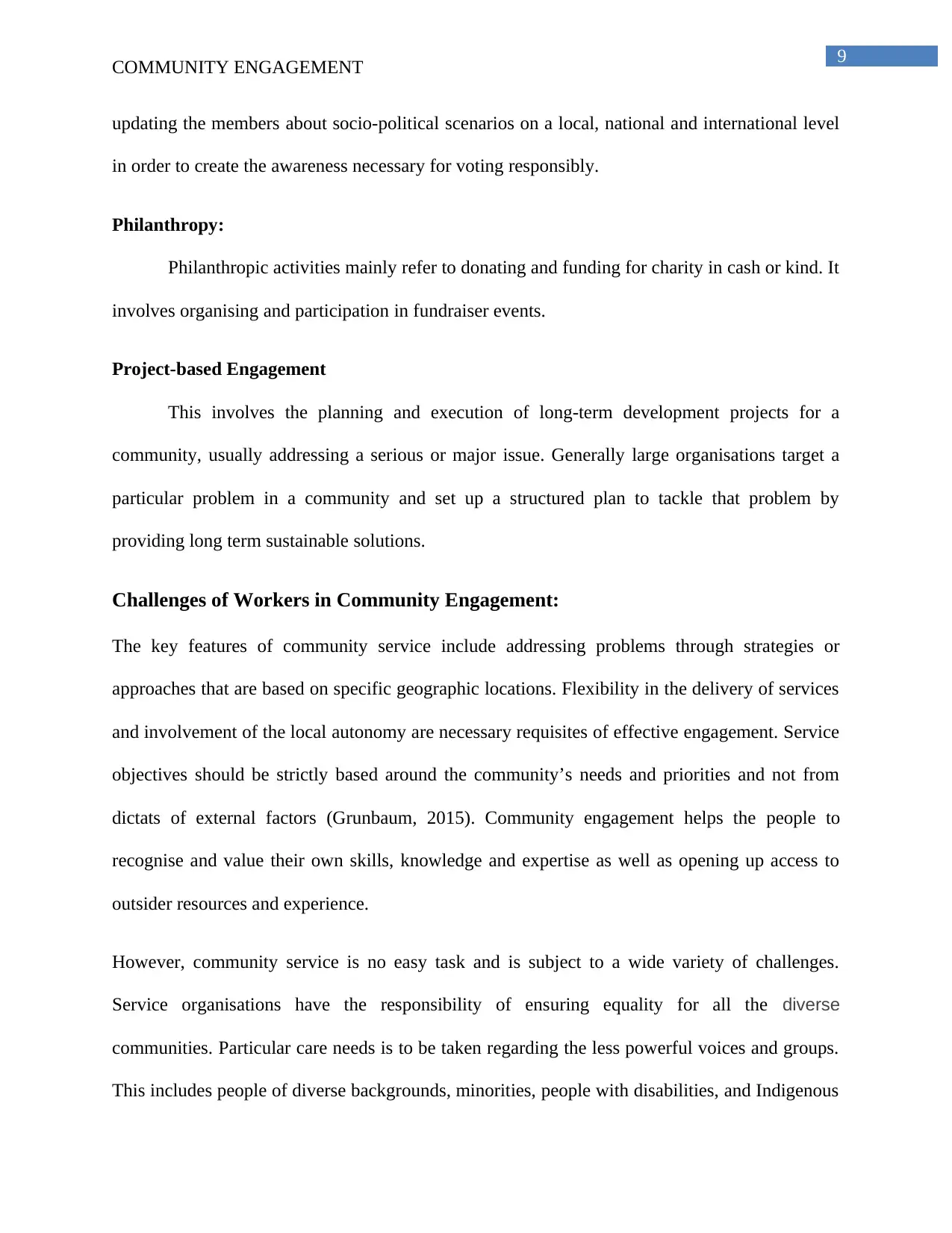
9
COMMUNITY ENGAGEMENT
updating the members about socio-political scenarios on a local, national and international level
in order to create the awareness necessary for voting responsibly.
Philanthropy:
Philanthropic activities mainly refer to donating and funding for charity in cash or kind. It
involves organising and participation in fundraiser events.
Project-based Engagement
This involves the planning and execution of long-term development projects for a
community, usually addressing a serious or major issue. Generally large organisations target a
particular problem in a community and set up a structured plan to tackle that problem by
providing long term sustainable solutions.
Challenges of Workers in Community Engagement:
The key features of community service include addressing problems through strategies or
approaches that are based on specific geographic locations. Flexibility in the delivery of services
and involvement of the local autonomy are necessary requisites of effective engagement. Service
objectives should be strictly based around the community’s needs and priorities and not from
dictats of external factors (Grunbaum, 2015). Community engagement helps the people to
recognise and value their own skills, knowledge and expertise as well as opening up access to
outsider resources and experience.
However, community service is no easy task and is subject to a wide variety of challenges.
Service organisations have the responsibility of ensuring equality for all the diverse
communities. Particular care needs is to be taken regarding the less powerful voices and groups.
This includes people of diverse backgrounds, minorities, people with disabilities, and Indigenous
COMMUNITY ENGAGEMENT
updating the members about socio-political scenarios on a local, national and international level
in order to create the awareness necessary for voting responsibly.
Philanthropy:
Philanthropic activities mainly refer to donating and funding for charity in cash or kind. It
involves organising and participation in fundraiser events.
Project-based Engagement
This involves the planning and execution of long-term development projects for a
community, usually addressing a serious or major issue. Generally large organisations target a
particular problem in a community and set up a structured plan to tackle that problem by
providing long term sustainable solutions.
Challenges of Workers in Community Engagement:
The key features of community service include addressing problems through strategies or
approaches that are based on specific geographic locations. Flexibility in the delivery of services
and involvement of the local autonomy are necessary requisites of effective engagement. Service
objectives should be strictly based around the community’s needs and priorities and not from
dictats of external factors (Grunbaum, 2015). Community engagement helps the people to
recognise and value their own skills, knowledge and expertise as well as opening up access to
outsider resources and experience.
However, community service is no easy task and is subject to a wide variety of challenges.
Service organisations have the responsibility of ensuring equality for all the diverse
communities. Particular care needs is to be taken regarding the less powerful voices and groups.
This includes people of diverse backgrounds, minorities, people with disabilities, and Indigenous
Paraphrase This Document
Need a fresh take? Get an instant paraphrase of this document with our AI Paraphraser
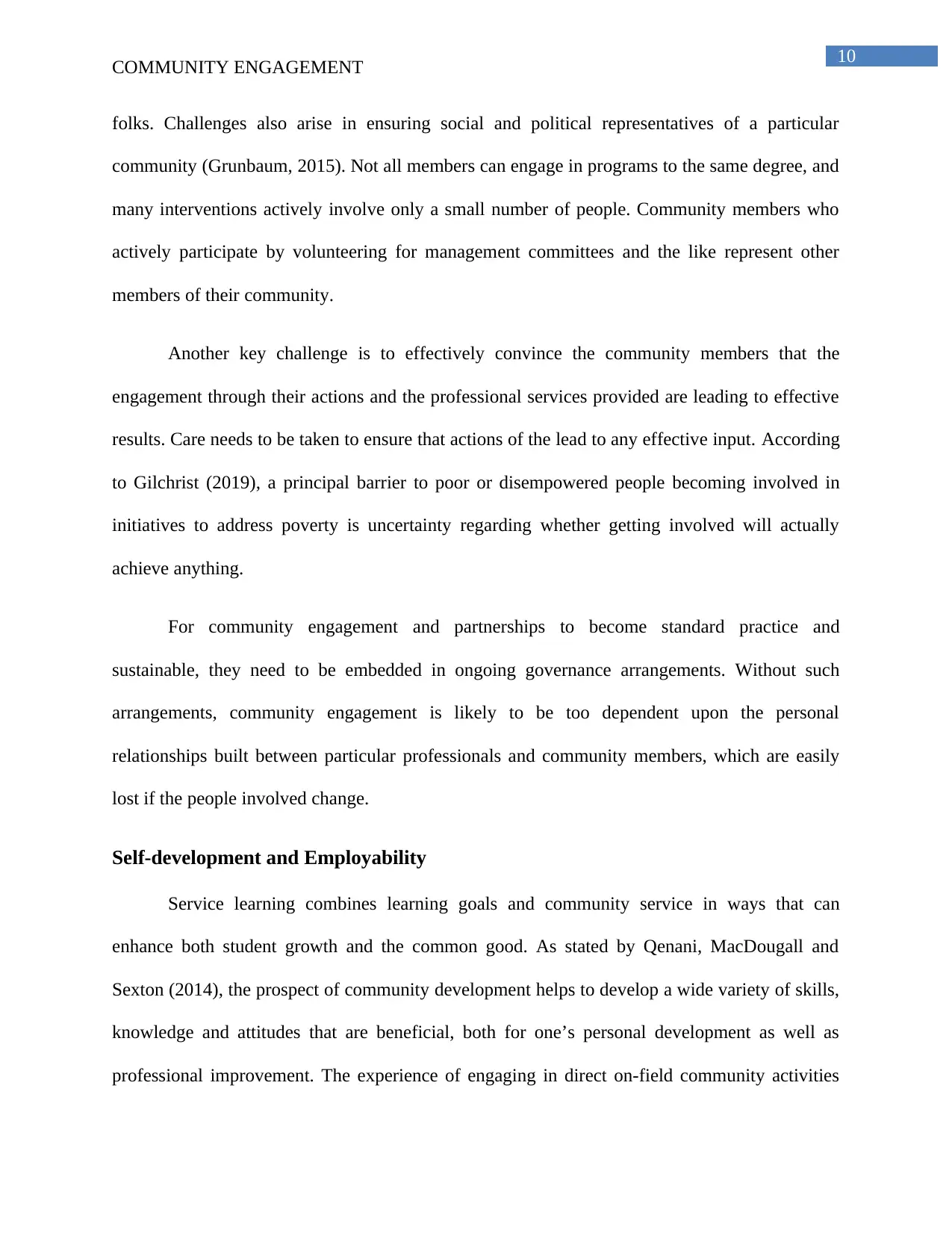
10
COMMUNITY ENGAGEMENT
folks. Challenges also arise in ensuring social and political representatives of a particular
community (Grunbaum, 2015). Not all members can engage in programs to the same degree, and
many interventions actively involve only a small number of people. Community members who
actively participate by volunteering for management committees and the like represent other
members of their community.
Another key challenge is to effectively convince the community members that the
engagement through their actions and the professional services provided are leading to effective
results. Care needs to be taken to ensure that actions of the lead to any effective input. According
to Gilchrist (2019), a principal barrier to poor or disempowered people becoming involved in
initiatives to address poverty is uncertainty regarding whether getting involved will actually
achieve anything.
For community engagement and partnerships to become standard practice and
sustainable, they need to be embedded in ongoing governance arrangements. Without such
arrangements, community engagement is likely to be too dependent upon the personal
relationships built between particular professionals and community members, which are easily
lost if the people involved change.
Self-development and Employability
Service learning combines learning goals and community service in ways that can
enhance both student growth and the common good. As stated by Qenani, MacDougall and
Sexton (2014), the prospect of community development helps to develop a wide variety of skills,
knowledge and attitudes that are beneficial, both for one’s personal development as well as
professional improvement. The experience of engaging in direct on-field community activities
COMMUNITY ENGAGEMENT
folks. Challenges also arise in ensuring social and political representatives of a particular
community (Grunbaum, 2015). Not all members can engage in programs to the same degree, and
many interventions actively involve only a small number of people. Community members who
actively participate by volunteering for management committees and the like represent other
members of their community.
Another key challenge is to effectively convince the community members that the
engagement through their actions and the professional services provided are leading to effective
results. Care needs to be taken to ensure that actions of the lead to any effective input. According
to Gilchrist (2019), a principal barrier to poor or disempowered people becoming involved in
initiatives to address poverty is uncertainty regarding whether getting involved will actually
achieve anything.
For community engagement and partnerships to become standard practice and
sustainable, they need to be embedded in ongoing governance arrangements. Without such
arrangements, community engagement is likely to be too dependent upon the personal
relationships built between particular professionals and community members, which are easily
lost if the people involved change.
Self-development and Employability
Service learning combines learning goals and community service in ways that can
enhance both student growth and the common good. As stated by Qenani, MacDougall and
Sexton (2014), the prospect of community development helps to develop a wide variety of skills,
knowledge and attitudes that are beneficial, both for one’s personal development as well as
professional improvement. The experience of engaging in direct on-field community activities
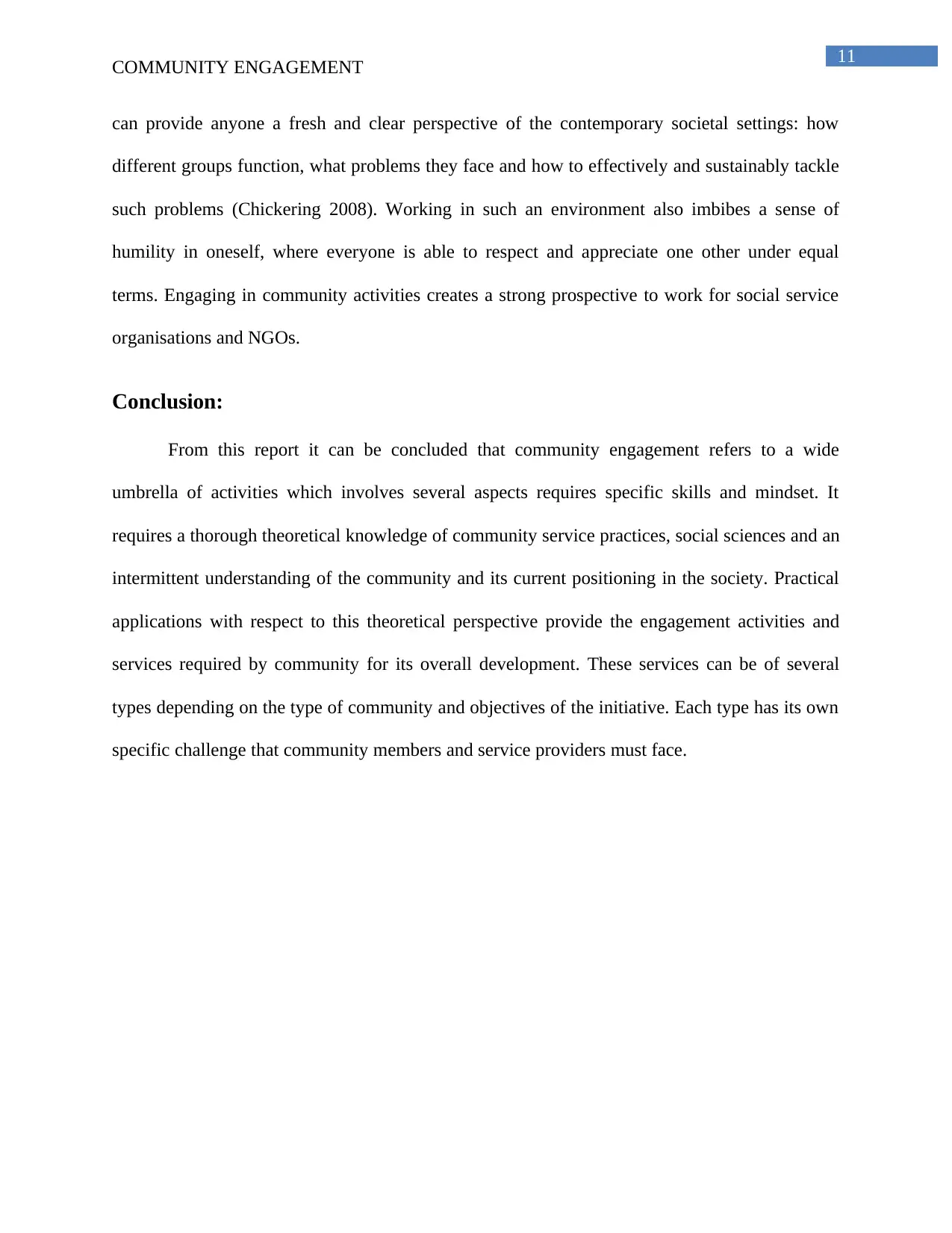
11
COMMUNITY ENGAGEMENT
can provide anyone a fresh and clear perspective of the contemporary societal settings: how
different groups function, what problems they face and how to effectively and sustainably tackle
such problems (Chickering 2008). Working in such an environment also imbibes a sense of
humility in oneself, where everyone is able to respect and appreciate one other under equal
terms. Engaging in community activities creates a strong prospective to work for social service
organisations and NGOs.
Conclusion:
From this report it can be concluded that community engagement refers to a wide
umbrella of activities which involves several aspects requires specific skills and mindset. It
requires a thorough theoretical knowledge of community service practices, social sciences and an
intermittent understanding of the community and its current positioning in the society. Practical
applications with respect to this theoretical perspective provide the engagement activities and
services required by community for its overall development. These services can be of several
types depending on the type of community and objectives of the initiative. Each type has its own
specific challenge that community members and service providers must face.
COMMUNITY ENGAGEMENT
can provide anyone a fresh and clear perspective of the contemporary societal settings: how
different groups function, what problems they face and how to effectively and sustainably tackle
such problems (Chickering 2008). Working in such an environment also imbibes a sense of
humility in oneself, where everyone is able to respect and appreciate one other under equal
terms. Engaging in community activities creates a strong prospective to work for social service
organisations and NGOs.
Conclusion:
From this report it can be concluded that community engagement refers to a wide
umbrella of activities which involves several aspects requires specific skills and mindset. It
requires a thorough theoretical knowledge of community service practices, social sciences and an
intermittent understanding of the community and its current positioning in the society. Practical
applications with respect to this theoretical perspective provide the engagement activities and
services required by community for its overall development. These services can be of several
types depending on the type of community and objectives of the initiative. Each type has its own
specific challenge that community members and service providers must face.
⊘ This is a preview!⊘
Do you want full access?
Subscribe today to unlock all pages.

Trusted by 1+ million students worldwide
1 out of 14
Related Documents
Your All-in-One AI-Powered Toolkit for Academic Success.
+13062052269
info@desklib.com
Available 24*7 on WhatsApp / Email
![[object Object]](/_next/static/media/star-bottom.7253800d.svg)
Unlock your academic potential
Copyright © 2020–2025 A2Z Services. All Rights Reserved. Developed and managed by ZUCOL.





